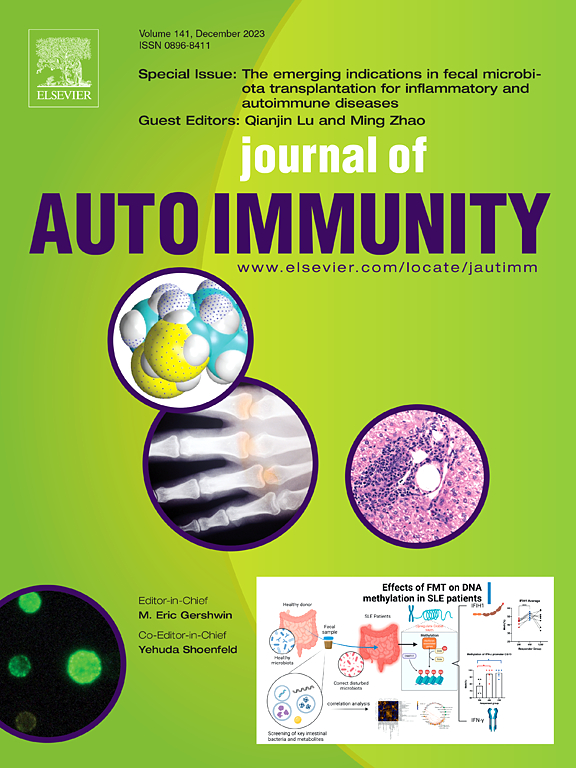Machine learning approach to single cell transcriptomic analysis of Sjogren's disease reveals altered activation states of B and T lymphocytes
IF 7
1区 医学
Q1 IMMUNOLOGY
引用次数: 0
Abstract
Sjogren's Disease (SjD) is an autoimmune disorder characterized by salivary and lacrimal gland dysfunction and immune cell infiltration leading to gland inflammation and destruction. Although SjD is a common disease, its pathogenesis is not fully understood. In this study, we conducted a single-cell transcriptome analysis of peripheral blood mononuclear cells (PBMC) from patients with SjD and symptomatic non-SjD controls to identify cell types and functional changes involved in SjD pathogenesis. All PBMCs populations showed marked differences in gene expression between SjD patients and controls, particularly an increase in interferon (IFN) signaling gene signatures. T and B cells of SjD patients displayed a depletion of ribosomal gene expression and pathways linked to protein translation. SjD patients had increased frequencies of naive B cells, which featured a unique gene expression profile (GEP) distinct from controls and had hallmarks of B cell hyperactivation. Non-negative matrix factorization (NMF) also identified several non-overlapping GEPs in CD4+ and CD8+ T cells with differential usage in SjD patients and controls. Of these, only the Th1 activation GEP was enriched in T cells of SjD patients whereas the other two GEPs were depleted in T cells, emphasizing the important role of Th1 cells in SjD. Our study provides evidence for aberrant and unique gene expression patterns in both B and T lymphocytes of SjD patients that point to their altered activation states and may provide new insights into the pathogenesis of SjD.
机器学习方法对干燥病的单细胞转录组学分析揭示了B和T淋巴细胞激活状态的改变
干燥病(SjD)是一种自身免疫性疾病,以唾液腺和泪腺功能障碍和免疫细胞浸润导致腺体炎症和破坏为特征。虽然SjD是一种常见病,但其发病机制尚不完全清楚。在这项研究中,我们对SjD患者和症状性非SjD对照组的外周血单核细胞(PBMC)进行了单细胞转录组分析,以确定SjD发病过程中涉及的细胞类型和功能变化。所有PBMCs群体在SjD患者和对照组之间的基因表达都有显著差异,特别是干扰素(IFN)信号基因特征的增加。SjD患者的T和B细胞表现出核糖体基因表达和与蛋白质翻译相关的途径的缺失。SjD患者初始B细胞的频率增加,其特征是独特的基因表达谱(GEP)不同于对照组,具有B细胞过度活化的特征。非阴性基质因子分解(NMF)也在SjD患者和对照组的CD4+和CD8+ T细胞中发现了几种非重叠的GEPs。其中,只有Th1激活GEP在SjD患者的T细胞中富集,而其他两种GEP在T细胞中缺失,强调了Th1细胞在SjD中的重要作用。我们的研究为SjD患者B淋巴细胞和T淋巴细胞异常和独特的基因表达模式提供了证据,这些基因表达模式指向了它们激活状态的改变,并可能为SjD的发病机制提供新的见解。
本文章由计算机程序翻译,如有差异,请以英文原文为准。
求助全文
约1分钟内获得全文
求助全文
来源期刊

Journal of autoimmunity
医学-免疫学
CiteScore
27.90
自引率
1.60%
发文量
117
审稿时长
17 days
期刊介绍:
The Journal of Autoimmunity serves as the primary publication for research on various facets of autoimmunity. These include topics such as the mechanism of self-recognition, regulation of autoimmune responses, experimental autoimmune diseases, diagnostic tests for autoantibodies, as well as the epidemiology, pathophysiology, and treatment of autoimmune diseases. While the journal covers a wide range of subjects, it emphasizes papers exploring the genetic, molecular biology, and cellular aspects of the field.
The Journal of Translational Autoimmunity, on the other hand, is a subsidiary journal of the Journal of Autoimmunity. It focuses specifically on translating scientific discoveries in autoimmunity into clinical applications and practical solutions. By highlighting research that bridges the gap between basic science and clinical practice, the Journal of Translational Autoimmunity aims to advance the understanding and treatment of autoimmune diseases.
 求助内容:
求助内容: 应助结果提醒方式:
应助结果提醒方式:


